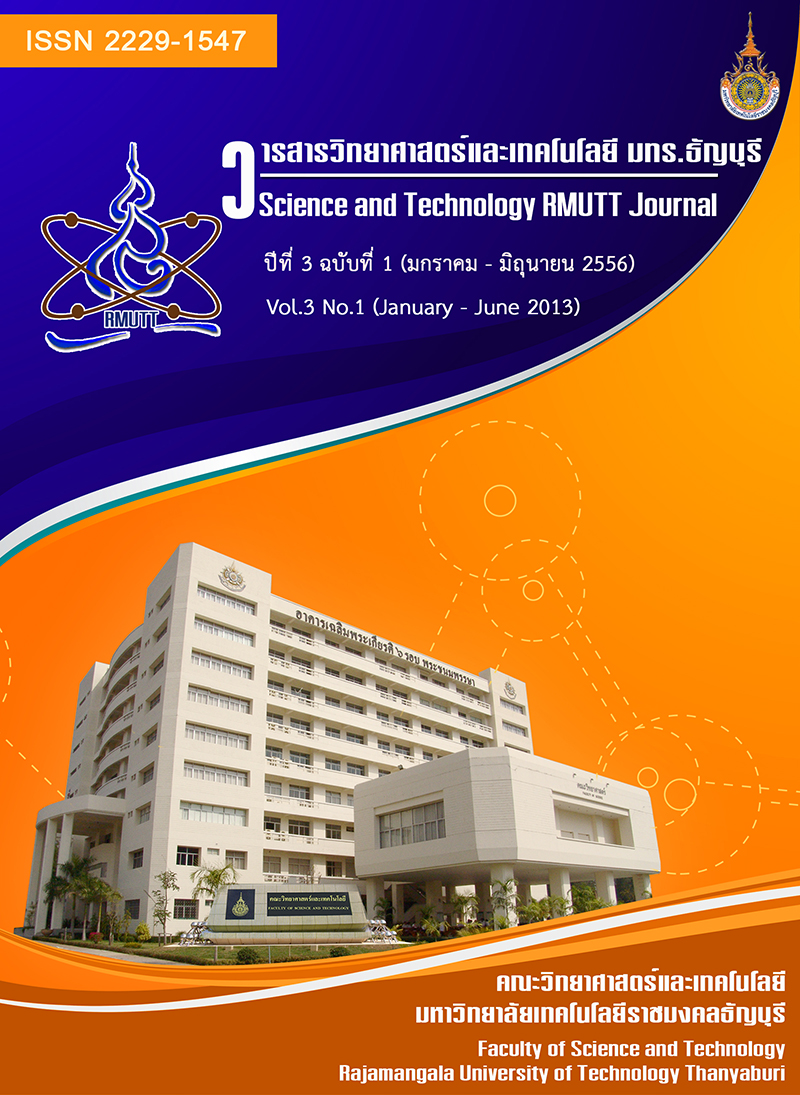A Study on Efficiency of Effective Microoraganisms of Waste Water Treatment
Main Article Content
Abstract
The study on the two formula of effective microbial (EM) production was studied. EM Formula 1, the ingredients were 20 liters of water, 1 liter of molasses mixed with 1 liter of the concentrated effective microorganisms starter. Ingredients of EM formula 2 were 20 liters of water, 1 liter of molasses, 50 kilograms of chopped fruits and vegetables, 1 liter of effective microorganisms obtained from formula 1 and 5-10 milliliters of the concentrated effective microorganisms starter. The two EM Formula were used in a model for waste water treatment conducted in a laboratory. The result of the study and the statistic analysis showed that the efficiency between EM formula 1 and formula 2 for waste water treatment was not significance difference at level of 0.05.
From this study, the production cost of EM formula 2 was lower than EM formula 1. EM formula 2 was therefore used for waste water treatment in the real field work in some locations of water sources inside Rajamangala University of Thanyaburi (RMUTT). The result of this field experiment showed the decreases in the water chemical parameters especially the Biological Oxygen Demand (BOD), Chemical Oxygen Demand (COD) and Ammonia – nitrate in all experimented water sources. Based on the quality of surface water determined by National Environmental Committee of Thailand 1994, the water quality in the experimented in RMUTT has been improved and location classified to be in category 3-4 after treated by EM formula 2.
Article Details
References
จำเรียง หนูสีแก้ว อรวรรณ บุญธรรม ฉัตร ผลนาค และ สุวิทย์ เพชรห้วยลึก. 2548. การวิเคราะห์หาธาตุองค์ประกอบของน้ำแร่จากแหล่งน้ำพุร้อนธรรมชาติบางแหล่งน้ำในพื้นที่จังหวัดสงขลา และจังหวัดพัทลุง โดยใช้เทคนิคการเรืองรังสีเอ็กซ์. วารสารวิทยาศาสตร์ทักษิณ. ปีที่ 2 ฉบับที่ 2.
ชวนพิศ อรุณรังสิกุล, ชัยณรงค์ รัตนกรีฑากุล, รุ่งนภา ก่อประดิษฐ์สกุล และธีรนุต ร่มโพธิ์ภักดิ์. 2547. คุณภาพน้ำหมักชีวภาพและองค์ประกอบ. การประชุมทางวิชาการมหาวิทยาลัยเกษตรศาสตร์. ครั้งที่ 42: สาขาพืช สาขาส่งเสริมและนิเทศศาสตรเกษตร 3 - 6 กุมภาพันธ์, กรุงเทพ.
นันทนาคชเสนี. 2539. คู่มือปฏิบัติการนิเวศวิทยาน้ำจืด. พิมพ์ครั้งที่ 2. สำนักพิมพ์จุฬาลงกรณ์มหาวิทยาลัย, กรุงเทพฯ.
รวีพร รุพันธ์ ณัฐวุฒิ หวังสมนึก และสิทธากร กันโอภาส. 2555. การทดสอบประสิทธิภาพของ EM ball เพื่อใช้ในการบำบัดน้ำเสีย. รายงานการฝึกสหกิจศึกษา ณ ห้องปฎิบัติการสาหร่ายประยุกต์ คณะวิทยาศาสตร์ มหาวิทยาลัยเชียงใหม่.
วาสนา การสุวรรณ และศราพร ตันจริง. 2546. การศึกษาประสิทธิภาพของ EM ในการบำบัดไขมันจากบ่อดักไขมันของร้านจำหน่ายอาหาร. มหาสารคาม: สาขาเทคโนโลยีสิ่งแวดล้อม คณะเทคโนโลยี
มหาวิทยาลัยมหาสารคราม.
ไมตรี ดวงสวัสดิ์และจารุวรรณ สมศิริ. 2528. คุณสมบัติของน้ำและวิธีวิเคราะห์สำหรับการวิจัยทางการประมง ฝ่ายวิจัยสิ่งแวดล้อมสัตว์น้ำ. สถาบันประมงน้ำจืดแห่งชาติ. กรมประมงกระทรวงเกษตรและสหกรณ์.
APHA, AWWA and WP CF. 1992. Standard methods for the examination of water and wastewater. (18thed). Washington D.C., American Public Health Association.


